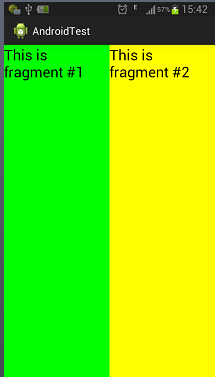碎片——Fragment
post by:追风剑情 2015-10-11 15:43
一、创建碎片1
视图
<?xml version="1.0" encoding="utf-8"?>
<LinearLayout xmlns:android="http://schemas.android.com/apk/res/android"
android:layout_width="fill_parent"
android:layout_height="fill_parent"
android:orientation="vertical"
android:background="#00FF00" >
<TextView
android:layout_width="fill_parent"
android:layout_height="wrap_content"
android:text="This is fragment #1"
android:textColor="#000000"
android:textSize="25sp"/>
</LinearLayout>
代码
package com.example.androidtest;
import android.app.Fragment;
import android.os.Bundle;
import android.view.LayoutInflater;
import android.view.View;
import android.view.ViewGroup;
public class Fragment1 extends Fragment{
@Override
public View onCreateView(LayoutInflater inflater,
ViewGroup container,
Bundle savedInstanceState)
{
return inflater.inflate(R.layout.fragment1, container, false);
}
}
二、创建碎片2
视图
<?xml version="1.0" encoding="utf-8"?>
<LinearLayout xmlns:android="http://schemas.android.com/apk/res/android"
android:layout_width="fill_parent"
android:layout_height="fill_parent"
android:orientation="vertical"
android:background="#FFFE00" >
<TextView
android:layout_width="fill_parent"
android:layout_height="wrap_content"
android:text="This is fragment #2"
android:textColor="#000000"
android:textSize="25sp"/>
</LinearLayout>
代码
package com.example.androidtest;
import android.app.Fragment;
import android.os.Bundle;
import android.view.LayoutInflater;
import android.view.View;
import android.view.ViewGroup;
public class Fragment2 extends Fragment {
@Override
public View onCreateView(LayoutInflater inflater,
ViewGroup container,
Bundle savedInstanceState)
{
return inflater.inflate(R.layout.fragment2, container, false);
}
}
三、创建活动
视图
<LinearLayout xmlns:android="http://schemas.android.com/apk/res/android"
xmlns:tools="http://schemas.android.com/tools"
android:layout_width="fill_parent"
android:layout_height="fill_parent"
android:orientation="horizontal"
tools:context="${relativePackage}.${activityClass}" >
<fragment
android:name="com.example.androidtest.Fragment1"
android:id="@+id/fragment1"
android:layout_weight="1"
android:layout_width="0px"
android:layout_height="match_parent" />
<fragment
android:name="com.example.androidtest.Fragment2"
android:id="@+id/fragment2"
android:layout_weight="1"
android:layout_width="0px"
android:layout_height="match_parent" />
</LinearLayout>
代码
package com.example.androidtest;
import android.app.Activity;
import android.os.Bundle;
public class FragmentsActivity extends Activity {
@Override
protected void onCreate(Bundle savedInstanceState) {
super.onCreate(savedInstanceState);
setContentView(R.layout.activity_fragments);
}
}
运行效果
注意: 除了Fragment基类,碎片还可以继承Fragment类的几个子类,例如Dialogfragment、ListFragment和PreferenceFragment。
注意: 每个碎片都需要一个唯一标识符,这可以通过android:id或android:tag属性进行设置。
评论:
发表评论:
